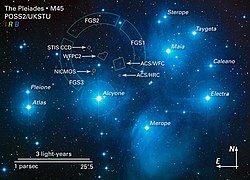Merope (star)
| Observation data Epoch J2000 Equinox J2000 |
|
|---|---|
| Constellation | Taurus |
| Right ascension | 03h 46m 19.5739s |
| Declination | 23° 56′ 54.090″ |
| Apparent magnitude (V) | 4.113 |
| Characteristics | |
| Spectral type | B6IVe |
| U−B color index | -0.41 |
| B−V color index | -0.06 |
| Variable type | Beta Cephei |
| Astrometry | |
| Radial velocity (Rv) | 6.2 km/s |
| Proper motion (μ) |
RA: 21.17 mas/yr Dec.: -42.67 mas/yr |
| Parallax (π) | 9.08 ± 1.04mas |
| Distance | approx. 360 ly (approx. 110 pc) |
| Absolute magnitude (MV) | −1.07 |
| Details | |
| Radius | 5.1 R☉ |
| Surface gravity (log g) | 4.0 cgs |
| Temperature | 13,360 ± 340 K |
| Other designations | |
| Database references | |
| SIMBAD | data |
Merope, designated 23 Tauri (abbreviated 23 Tau), is a star in the constellation of Taurus and a member of the Pleiades star cluster. It is approximately 360 light years from the Sun.
Merope is a blue-white B-type subgiant with a mean apparent magnitude of +4.14. Richard Hinckley Allen described the star as lucid white and violet. It has a luminosity of 630 times that of the Sun and a surface temperature of 14,000 kelvins. Merope's mass is roughly 4.5 solar masses and has a radius more than 4 times as great as the Sun's. It is classified as a Beta Cephei type variable star and its brightness varies by 0.01 magnitudes.
Surrounding Merope is the Merope Nebula. Part of the nebula that the Pleiades Cluster is currently passing through, it appears brightest around Merope and is listed in the Index Catalogue as number IC 349.
23 Tauri is the star's Flamsteed designation. The name Merope originates with Greek mythology; she is one of the seven daughters of Atlas and Pleione known as the Pleiades. In 2016, the International Astronomical Union organized a Working Group on Star Names (WGSN) to catalog and standardize proper names for stars. The WGSN's first bulletin of July 2016 included a table of the first two batches of names approved by the WGSN; which included Merope for this star. It is now so entered in the IAU Catalog of Star Names.
...
Wikipedia

